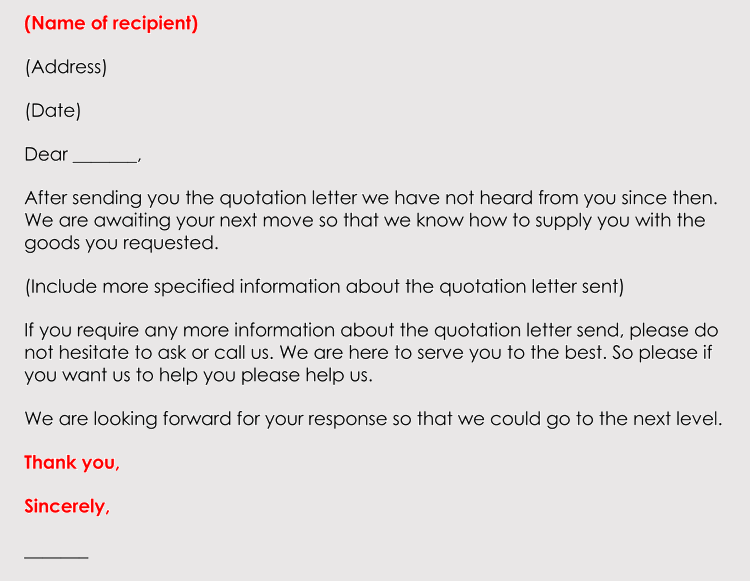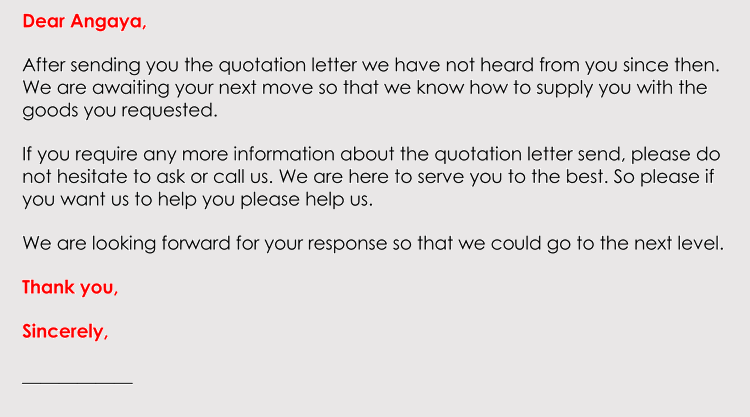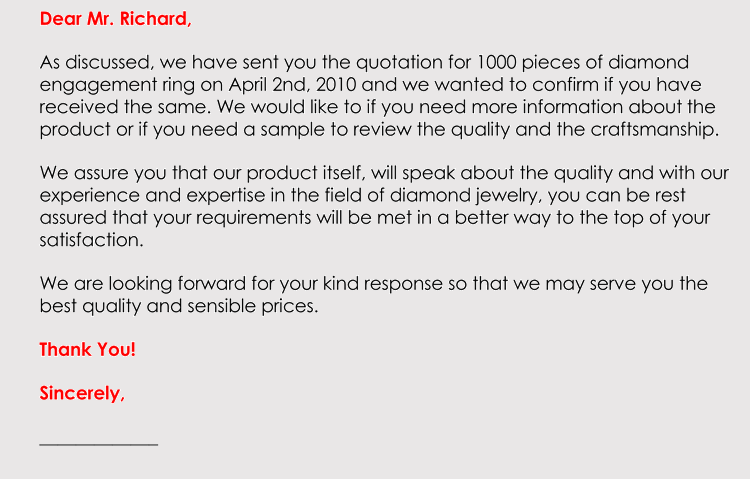Once you have established a lead and prepared a quotation for your client, the only thing you can do is wait. As a supplier, your aim should be to prepare a proper quotation that will let potential buyers know how much it will cost them to access your goods or services before they can commit to making the purchase. However, your client might fail to respond for weeks or even months. So giving up is not the answer in this case.
As a supplier, you need to find a way to convince your lead and turn them into committed clients.
The best approach is to prepare a follow up email to client after quotation.
At times, a lack of response might mean that they are not interested, and at times it might mean that they are thoroughly going through your quote while entertaining other quotes. Preparing a proper follow-up email and sending it to them promptly will improve your chances of turning them into committed clients.
There are many reasons why a follow-up email after a quote is essential. First, as the supplier, you will likely easily impress or convince the potential client with your commitment. This will increase your chances of getting a positive response from them. The potential client will view you as an organized supplier who cares about customer satisfaction. Also, they will view you as an interested party who wants the best for their business. Finally, follow-ups usually turn into customers; who purchase your product or service and help you make money.
That is why, as a supplier, it is crucial to know how to prepare a proper follow-up email after a quotation. Using this article, you will learn how to prepare your email, why you should follow up, and how you can effectively follow up on your lead.
Why Should You Follow-Up on Quotes?
There are reasons why a supplier should follow up on quotes. With a follow-up email to your client, you can keep the communication line between you and your potential client open. This means they can easily reach you for answers if they missed the quotation email, want some clarification, or want more information before committing.
Another important reason you should follow up on quotes is that you will be able to form a relationship with your prospective customer. Your lead will feel connected to you and your business based on the personalized follow-up email. With that being the case, you will likely attract them to buy your goods or services. This way, a working relationship will be formed to benefit both your business and theirs.
How Can You Follow-Up on Quotes?
There are three ways to follow up on quotes sent to potential clients. However, you need to organize your paperwork before picking a method and conducting a follow-up. The idea is to ensure that you keep track of all contacted customers, have records of the time you contacted them and be aware of the services or products you offered in the quotation(s).
Organizing your paperwork will ensure that you avoid contacting the wrong customer, sending too many follow-up messages, and following up when it is too late. In addition, you can use software of your choice to help you organize your customer’s details, review previous quotes, jobs, visits, invoices, and billing records, access client accounts, attach required notes to these client accounts, and manage new leads for faster response.
Here are the three ways you can use to follow up on a quote:
Follow-up by an email
As a supplier, a follow-up email is the most convenient and effective way you can use it. You can either use manual or automated emails. You will need to write, be personalized, and send the email to each client for manual emails. Clients will receive a customized email whenever you follow up on a quote.
The manual email is appropriate if you are a supplier with a few clients and have potential leads. However, you will need to write the emails yourself, even when busy, or provide your email logins to your employees when you ask them for help.
Automated emails are appropriate for a big or growing business. You will need to prepare a simple follow-up email sent automatically to the chosen client(s). Using the client management software, you can organize the client’s details and choose when the automated email should be sent. Automated emails allow you to follow up on various clients at a go while having extra time to complete your work.
Follow-up text messages
Follow-up text messages are also an option, especially if your client prefers texting. For this case, you can use manual or automated text messages to follow up on a client. Manual text messages require you to prepare a customized text message each time you want to follow up on your client. This works best if you have a few clients and the business is still tiny. However, this method is time-consuming, needs a lot of effort, and is prone to typing errors.
Automated text messages are easier and faster, ensuring a proper two-way conversation between you and your client. Also, you can easily keep track of your many clients, and your employees can easily access any quotes, invoices, or work request information from clients. That means you will have a team that can readily prepare answers for your customers and promptly shares this information with the clients.
Follow-up by a call
Although this option is less popular than the two mentioned above, you can use it to add a personal touch to the follow-up. However, a follow-up phone call is inconvenient for you and the client, making it hard to keep track and very time-consuming. Also, a follow-up phone call does not provide records for future reference like texts and emails. As a supplier, you can still use a follow-up phone call only with those clients who have requested it.
Note: Ensure you use the same method to send a quote to the client to follow up on the quotation. In other cases, use a follow-up method the customer prefers to ensure that you retain them. Also, it is essential to do homework to find out what the client needs. This means you should research the company owners and communicate with them directly, identify the information they need to influence their decision about you positively, and ask proper follow-up questions to benefit your business in the future.
Information to Include in a Follow Up Email to Client after Quotation
After selecting the most appropriate follow-up method that benefits both you and your client, you need to know the content that must be present in your follow-up email.
Here is the information you need to include in a follow-up email to the client after the quotation:
Provide an eye-catchy subject line
Every email requires a subject line, and your follow-up email should have an eye-catchy one. Subject lines are important as they determine whether your client will open the email or not. That means you need to have an impressive subject line, which is well-written, precise, and clear, reflects the message in your email, and will catch the reader’s attention.
Reference your previous email
To ensure your client is aware of what you are talking about, ensure that you remind them of the previous email. Referencing your previous email will motivate a client who did not open the quotation email to do so and also remind those who have read the quotation to give you a response.
Here are some phrases you can use to reference your previous email:
- “Following up on my previous email about….”
- “In reference to my offer….”
- “Just checking in to see if you had a chance to look at my offer.”
- “Re: My offer from….”
- “I sent an email on [date], and I’m interested to know what you thought about it….”
- “As per our previous correspondence…”
Include clear objectives
Ensure that you include clear objectives in the email. Depending on what you find out from the client after providing them with a quotation, you may include some objectives: providing more information, reminding the client to respond, or scheduling a meeting with them.
Having a clear objective will allow the client to identify exactly what you want and what they need to do.
Ask questions
In your follow-up email, you should include relevant questions that will help you understand why they have not responded to your quotation email. By including questions in your email, you might learn that your client is not interested, has been busy, forgot to reply, or has not been available. Whatever the case, you must ask polite and non-pushy questions to determine your way forward with the client.
Provide further explanation
It is also essential to provide further explanation in your follow-up email. Sometimes, no response from a client results from a lack of information. Writing a follow-up email to the client with more information about the quotation is a sure way of triggering a response from such clients. You can add more values and materials, answer questions they might have, or even offer to schedule a meeting for more discussions.
Persuade the client
As a supplier, you need to understand that persuasion is essential in the world of sales. This means that you need to persuade your client in your follow-up email. You can do this by including answers to questions that the client might have, offering a face-to-face meeting with them, or even including extra content, such as blogs, videos, and how-to guides, about you and your products or services.
Add call to action
A call-to-action is essential in such an email. Adding one will increase your chances of getting a response from the client. For this section, you add links and ask them to access more details about you and your product or service by clicking on the links. You can also schedule a meeting and invite them for a product demonstration. Another way you can add a call-to-action is by scheduling a phone call to offer more explanation about the quotation.
Emphasize the value of your product
The final detail you must include in your follow-up email is an emphasis on the value of your product. First, you need to mention why your product is essential and relevant. Next, ensure that you repeat all the benefits that your product provides. Finally, focus on how your product will fulfill the client’s needs at that particular point in time.
Sample Letter
Dear Mr./Mrs.
Following our recent discussion, the company has sent you the quotation for catering to the wedding on 10th March 20xx, and we hope you received the same in good health. (any name of the company, product/service, and date can be put in this sentence)
If you need further information regarding our services or the quotation, the whole staff and I are available to answer any queries at any time. We assure you of our dedication to providing only the best catering services for our clients, and with our experience catering for weddings, we will do our part to make the day a resounding success.
I hope we will work together soon and await your favorable response.
Thank you for choosing us.
Sincerely,
Job Title
Company Name
Templates
How Long Should You Wait before Sending a Follow-Up Email?
You should wait about 3 to 5 days after sending the quotation before sending a follow-up email. This time is the perfect balance that allows the client to go through your quote. Sending a follow-up email too early will come off as being forceful while sending it too late might cause you to lose your potential client.
You also need to observe the day of the week and the time of the day when you should send the email. For example, it is best to send a follow-up email on Tuesday, Wednesday, or Thursday. For the time of the day, between 5 am and 6 am is the most appropriate as people are likely checking their inboxes. Also, sending it at around 5.07 am is better than 5 am on the dot as you will not come off as a stalker.
How to Make It Stand Out?
There are essential tips you need to observe when writing a follow-up email after a quotation for your client. Here are some of the tips:
Length and tone
Since your client is most likely busy, you must write a short follow-up email that maintains a professional tone. Your email should be between 50 and 125 words. Ensure that you grasp your recipient’s attention and then go straight to the point of your email. The tone should always be professional in a way that relates to your industry. However, you should avoid being too formal and try being a little bit friendly.
Pull the trigger
To catch the client’s attention subtly, you must include trigger words and phrases in your email. You can use trigger words:
Limited stock, free, easy, limited time, imagine, premium, secret, deal, save money, get the result, future, expiring now, guarantee, discover, and inspire.
You must ensure that you use these words and phrases appropriately, as they will likely trigger a response from your client. Ensure that you include these trigger words and phrases naturally that make them relevant to your message to prevent your email from going into spam.
Don’t be pushy
Sending various follow-ups is beneficial, but you should always avoid being pushy. At times, you might be dealing with a client who does not like saying no, and their lack of response acts as a way of saying that. Ensure that you can handle such situations and opt to focus your energy on other leads.
Be precise
Since this is a follow-up email, you need to learn to be precise with how you phrase your message. A follow-up email is not a long email with many paragraphs and unnecessary details. This email requires you to be precise and intentional with every detail you choose to include.
Other tips you should observe when writing a follow-up email to a client after a quotation include:
- Try repeating your main points throughout your message to ensure your client remembers them.
- Always thank your client at the end of the email for taking the time to consider your request. You can also ask about the next steps that should follow after the quote.
- Ensure that you give them enough time after sending the quotation before sending a follow-up email.
- After a reasonable time with no response on various follow-ups, you can try sending a follow-up to someone else.
Frequently Aksed Questions
Why should you follow up after a quote?
You should follow up after a quote because it will help you know if you are on the same page with the client and if they are interested in committing to purchase from you.
How do you write a follow-up email to a client after a quote?
To remain reputable and professional, you must ensure that you write a proper email that is not in the form of a text. Ensure that your follow-up email is brief, precise, and straight to the point, just like the email, you wrote to send a quotation to your client. Your focus should be to inquire if the client is interested in your quotation and whether you should schedule a date for the client to access your product or service.


